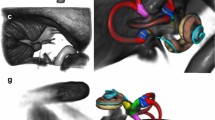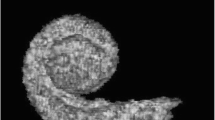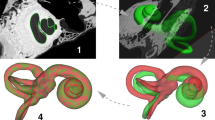Abstract
For the quantitative analysis of medical images in clinical research, diagnosis and treatment, a reliable basic framework for developing a normal human ear atlas of voxel-based computed tomography (CT) images was proposed. We annotated 10 precise ear structures with different labels from 64 patients with normal ear structures. Paired-samples t test, Pearson’s test and descriptive statistics were carried on the volume and coordinate data, which were first obtained from annotation to verify the correlation and difference. In addition, we constructed a three dimensional (3D) model of the standard human ear atlas with six views for presentation. Through a series of statistical analyses, a standard 3D normal human ear atlas containing volume and spatial data was obtained from voxel-based CT images. There was a significant negative correlation exists between age and the volume of the incus, and no correlation with other structures. There was no significant correlation between slice thickness and the volume of 10 structures. The volume of most structures on both sides is significantly correlated and there was no significant difference in the volume of most structures on both sides except for the jugular foramen. Besides, the coordinate range of the bilateral structures is relatively consistent. The specific volume and spatial data for the human ear atlas are helpful in the diagnosis of abnormalities, and this 3D normal human ear atlas will provide new insights for radiologists in clinical research.



Similar content being viewed by others
Abbreviations
- CT:
-
Computed tomography
- 3D:
-
Three dimensional
References
Brodmann, K. (2000). Brodmann’s Localisation in the Cerebral Cortex. Journal of Anatomy, 196(3), 493.
Fan, L., Li, H., Zhuo, J., et al. (2016). The human brainnetome atlas: A new brain atlas based on connectional architecture. Cerebral Cortex, 26(8), 3508.
Glasser, M. F., Coalson, T. S., Robinson, E. C., et al. (2016). A multi-modal parcellation of human cerebral cortex. Nature, 536(7615), 171.
Anson, B. J., & Bast, T. H. (1959). Development of the incus of the human ear; illustrated in atlas series. Quarterly Bulletin of the Northwestern University Medical School, 33(1), 44–59.
Saunders, W. H., Paparella, M. M., & Etter, B. A. (1980). Atlas of ear surgery. Maryland Heights: C.V. Mosby.
Harada, Y. (1983). Atlas of the ear by scanning electron microscopy. Journal of the Royal Society of Medicine, 77(1), 90.
Michaels, L. (1992). Atlas of ear, nose and throat pathology. Plastic and Reconstructive Surgery, 89(1), 153.
Bever, M. M., & Fekete, D. M. (2010). Atlas of the developing inner ear in zebrafish. Developmental Dynamics, 223(4), 536–543.
Koyabu, D. (2017). 3D atlas and comparative osteology of the middle ear ossicles among Eulipotyphla (Mammalia, Placentalia). MorphoMuseum, 02(03), e3.
Paterson, S., Tobias, K., Paterson, S., et al. (2013). Atlas of ear diseases of the dog and cat. Atlas of Ear Diseases of the Dog & Cat, 62(3), 160–185.
Mason, M. J. (2016). Structure and function of the mammalian middle ear. II: Inferring function from structure. Journal of Anatomy, 228(2), 300–312.
Stoessel, A., David, R., Gunz, P., et al. (2016). Morphology and function of Neandertal and modern human ear ossicles. Proceedings of the National Academy of Sciences of the United States of America, 113(41), 11489.
Ekdale, E. G. (2015). Correction: Comparative anatomy of the bony labyrinth (inner ear) of placental mammals. PLoS ONE, 10(8), e0137149.
Lyu, H. Y., Chen, K. G., Yin, D. M., et al. (2016). The age-related orientational changes of human semicircular canals. Clinical & Experimental Otorhinolaryngology, 9(2), 109–115.
Vincent, V. R., Frank, D. B., Paul, P., et al. (2016). Semicircular canal fibrosis as a biomarker for lateral semicircular canal function loss. Frontiers in Neurology, 7(43), 28.
Grohé, C., Tseng, Z. J., Lebrun, R., et al. (2016). Bony labyrinth shape variation in extant Carnivora: A case study of Musteloidea. Journal of Anatomy, 228(3), 366–383.
Basch, M. L., Brown, R. M., Jen, H., et al. (2015). Where hearing starts: The development of the mammalian cochlea. Journal of Anatomy, 228(2), 233–254.
Cureoglu, S., Baylan, M. Y., & Paparella, M. M. (2010). Cochlear otosclerosis. Current Opinion in Otolaryngology & Head & Neck Surgery, 18(5), 357–362.
Quesnel, A. M., Moonis, G., Appel, J., et al. (2013). Correlation of computed tomography with histopathology in otosclerosis. Otology & Neurotology, 34(1), 22–28.
Sennaroğlu, L., & Demir, B. M. (2017). Classification and current management of inner ear malformations. Balkan Medical Journal, 34(5), 397–411.
Alonso, F., Kassem, M. W., Iwanaga, J., et al. (2017). Anterior inferior cerebellar arteries juxtaposed with the internal acoustic meatus and their relationship to the cranial nerve VII/VIII complex. Cureus, 9(8), e1570.
Brook, C. D., Buch, K., Kaufmann, M., et al. (2015). The prevalence of high-riding jugular bulb in patients with suspected endolymphatic hydrops. Journal of Neurological Surgery Part B, 76(06), 471–474.
Kao, E., Kefayati, S., Amans, M. R., et al. (2017). Flow patterns in the jugular veins of pulsatile tinnitus patients. Journal of Biomechanics, 52, 61–67.
Acknowledgements
The work in this paper was supported by the Science and Technology Development Program of Beijing Education Committee (No. KM201810005026), the National Natural Science Foundation of China (No. 61871006), the National Natural Science Foundation of China (No. 61527807), Beijing Scholar 2015, and Beijing Municipal Administration of Hospitals’ Mission Plan (No. SML20150101).
Author information
Authors and Affiliations
Corresponding authors
Additional information
Publisher's Note
Springer Nature remains neutral with regard to jurisdictional claims in published maps and institutional affiliations.
Rights and permissions
About this article
Cite this article
Zhang, Y., Zhang, H., Zhuo, L. et al. A 3D Normal Human Ear Atlas of Voxel-Based CT Images. Sens Imaging 20, 19 (2019). https://doi.org/10.1007/s11220-019-0238-y
Received:
Revised:
Published:
DOI: https://doi.org/10.1007/s11220-019-0238-y




